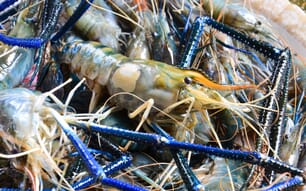Poor water quality that persists for days and weeks is detrimental to crawfish production. Water quality is influenced by many factors, both environmental and biological. Some environmental conditions such as temperature and rainfall are beyond the control of the farmer. Other factors, such as the type of vegetation planted for crawfish in summer, when the vegetation is planted, how the vegetation is managed prior to flooding the ponds and when the pond is flooded will influence water quality in crawfish ponds.
Most serious water quality problems occur in the fall, usually in the first two to six weeks after ponds are flooded and later in the early spring when pond water warms. All crawfish farmers will have water quality problems at some point during the production season, but the magnitude and severity is dramatically reduced at the outset by insuring ponds are properly designed, securing a stable and reliable water source, by matching the pumping capacity with production acreage, managing vegetation prior to flooding ponds in the fall and water after flooding and taking corrective management steps when water analysis tests indicate action is necessary.
Water Supply and Quantity Required
Both surface and subsurface water is acceptable for crawfish farming. Wells provide predator-free water, but they have a limited discharge capacity and higher investment and pumping costs. Because well water contains no oxygen and is usually high in soluble iron and toxic hydrogen sulfide, the water must be aerated to add oxygen and remove iron and sulfide prior to entering the pond (Figure 1). Surface water is satisfactory if it is pollution-free and if nuisance predatory fish are screened out. Although cheaper to pump, surface water is usually not as reliable in quantity and quality (Figure 2).
Pumps, motors and pipes must be matched to obtain the most efficient performance. Lift should be minimized as much as possible to reduce pumping costs. Pond location and local energy costs dictate the type of pump and power source best used for crawfish ponds. Surface water contains predatory fish that should be removed through a 1/2-inch mesh aeration screen (Figure 3). Smaller fish passing through the 1/2-inch mesh aeration screen usually don’t pose a serious predation problem to young crawfish. These fish are killed when the pond is drained in the summer. If pools or puddles containing fish persist in the pond bottom during the summer, it is important that the puddles be dried or treated with a fish toxicant prior to filling the pond in the fall to prevent contamination of the pond with predatory fish.
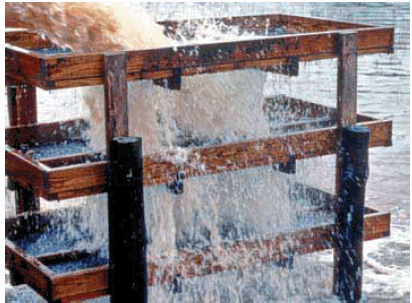
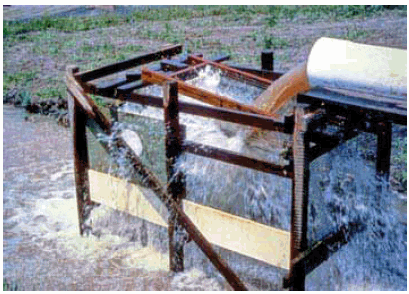
A pumping capacity of 75 to 100 gallons per minute per surface acre is ideal for intensive management strategies for crawfish ponds that average 14 to 18 inches deep when fully flooded. This pumping rate is sufficient to exchange all the water in the pond over four to five days. Complete water exchange may be required in the early fall when water is flooded onto vegetation. Warm weather leads to rapid plant decay and high demand for oxygen. When the water is depleted of oxygen for long periods, significant crawfish mortality or stress that reduces growth can occur. Ponds can be designed to circulate water and maintain satisfactory oxygen levels, thereby reducing pumping and water management cost (see Design and Construction in Chapter 4). Replacing bad water in the pond with
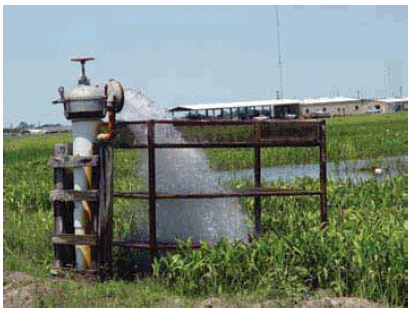
fresh, oxygenated water helps maintain satisfactory water quality. It is more effective to drain a portion of water from the pond and then pump oxygenated water to replace it than it is to drain and pump at the same time. By draining some of the water first and then re-filling, oxygenated water will be distributed through the entire pond. On the other hand, when draining and filling at the same time, many areas of the pond may not be properly flushed of bad water. Exchanging water in crawfish ponds to improve water quality is energy intensive and expensive, and decisions to do so should be based on the results from routine monitoring of water quality, especially oxygen content.
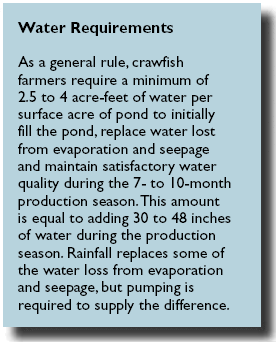
In reality, few crawfish farmers in Louisiana supply 75 to 100 gallons per minute of water per surface acre to crawfish ponds. The following management plan can be used when the water supply is not properly matched to the production acreage. By filling ponds to one-half normal depth at fall flood-up, a pump that supplies 35 to 50 gallons per minute per surface acre will provide sufficient capacity to replace water in several days if required. For example, if the pond is sufficiently level, it can be initially filled to 7 to 9 inches as opposed to 14 to 18 inches. Not only will there be less water to replace during low oxygen episodes, but less vegetation is submerged and oxygen demand is reduced. When temperatures have sufficiently cooled in winter, usually below 65 F, and oxygen demand is reduced, additional water can be added to bring the pond to full depth. One possible disadvantage of the shallow flood is that females with young burrowed near the top of the perimeter levee may not exit the burrow if rainfall in the fall and winter is limited. If the water supply is much less than 30 gallons per minute per surface acre, options for effectively managing water for optimal crawfish production are limited.
Water Quality
Water quality depends on management and on properly designed and constructed ponds that have a dependable water supply. Important water quality variables are dissolved oxygen, pH, total hardness, total alkalinity, iron, hydrogen sulfide content, ammonia, nitrite and salinity (salt content). Dissolved oxygen is the most important and low oxygen may be responsible for the death of more crawfish in ponds, either directly or indirectly, than any other factor. Temperature has a major effect on oxygen levels in ponds (Figure 4). Warm water cannot hold as much oxygen as cold water. Also, rising water temperature increases biological activity, so oxygen is consumed at a faster rate. When the water temperature increases from 70 F to 80 F, the rate of oxygen loss caused by decomposition doubles. Potential problems with insufficient oxygen can be expected whenever water temperature exceeds 70 F. During warm periods, ponds with an inadequate pumping capacity and excessive amounts of decaying vegetation will suffer from severe oxygen depletion, which can slow crawfish growth and reduce production if the condition is allowed to persist.
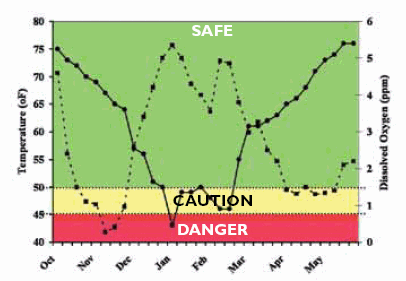
Crawfish are generally tolerant of low oxygen, but persistent exposure to extremely low oxygen for weeks can reduce production. The first two to six weeks after the initial flood-up is the most critical time for juvenile crawfish. Ideally, dissolved oxygen should be maintained above 2 parts per million (ppm) for good crawfish production but this content can be difficult, if not impossible, to sustain in the warmer months. When oxygen levels remain consistently below 1 ppm throughout the day for several weeks, crawfish become sufficiently stressed that they may cease feeding. Growth will slow and catch may significantly drop until oxygen levels increase. When oxygen levels remain below 0.5 ppm throughout the day for a week or more, newly hatched juveniles and molting crawfish may die. Larger crawfish stressed by low dissolved oxygen climb to the surface on vegetation or traps and expose their gills to higher oxygen levels at the surface (Figure 5). This behavior is usually not visually observed with juvenile crawfish because of their small size. The shelf life of live harvested crawfish in the cooler is reduced considerably if they have been exposed to low oxygen in ponds prior to harvest.
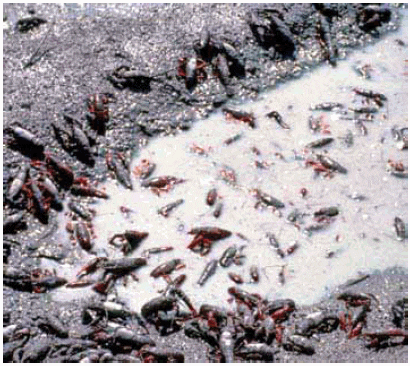
Because of high pumping costs, water management decisions should be based on oxygen measurements. No benefit to crawfish health and survival is gained by exchanging water if oxygen levels are satisfactory. Although pond water lacking in oxygen is often clear and dark (the color of tea, coffee or cola) and may have a smell of hydrogen sulfide (“rotten egg” odor), one should not rely on visual observation or smell to determine oxygen concentration. Dissolved oxygen can be checked several different ways. Dissolved oxygen meters are best if you have many ponds to check (Figure 6). Most producers, however, choose oxygen test kits because the kits are relatively inexpensive and simple to operate. The easiest kit uses a vacuum ampule that draws in a water sample. The value is determined by matching the color of the sample to a chart.
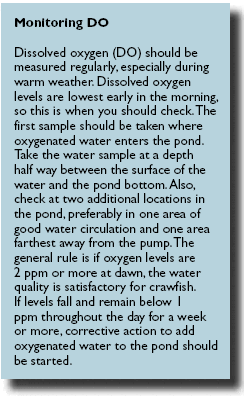
Oxygen deficiency is corrected by replacing or exchanging pond water with fresh, oxygenated water or by circulating and aerating existing water in the pond. Mechanical aerators, though not commonly used in the crawfish industry, are effective in aerating water in the vicinity of the aerator but are mostly ineffective in larger ponds with dense stands of vegetation because oxygen can not effectively be distributed throughout the pond. Installation of an aeration tower is recommended to oxygenate well water or surface water prior to it entering the pond. The aeration tower, if constructed properly, also will remove large predatory fish when using surface water. Pumping water through an aeration tower divides the water into small droplets (Figure 7). This technique gives maximum oxygen transfer to the water droplets. Properly designed aeration towers will add 1 to 2 pounds of oxygen to the water per horsepower hour. Well water is also aerated to some extent when it is exposed to the atmosphere as the water travels through flume ditches.
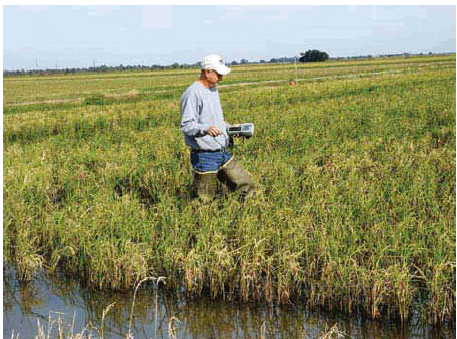
The source water pH after being aerated should range from 6.5 to 8.5, and both total hardness and total alkalinity should range from 50 ppm to 250 ppm as calcium carbonate. As a general rule, most waters and soils used for crawfish production in Louisiana are sufficiently high in hardness and alkalinity and do not require additions of agricultural limestone other than what may be required for the forage crop being cultivated. If the pH, hardness and alkalinity are low, incorporate agricultural limestone into the pond bottom during the next dry cycle. The amount of agricultural limestone required must be determined from a soil test analysis and the kind of forage crop to be grown during the summer. Water and soil samples can be analyzed by the LSU AgCenter’s Soil Testing and Plant Analysis Laboratory for a nominal fee, and recommendations will be provided as to the suitability of the water and soil for crawfish production with the results of the analysis. Contact your local LSU AgCenter extension office for instructions on submitting water and soil samples for analysis.
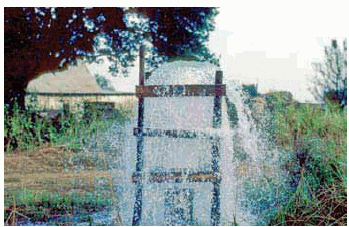

Dissolved iron and hydrogen sulfide are toxic to crawfish at concentrations often found in well water, but the two compounds are lowered to nonharmful concentrations when the water is oxygenated (Figure 8). Where iron and hydrogen sulfide concentrations are high, it may be necessary to place a flume ditch or pond between the well and the crawfish pond to allow the iron to settle out before entering the pond. Non-ionized ammonia and nitrite are toxic to crawfish at concentrations exceeding 2 ppm and 5 ppm (as nitrogen), respectively. Concentrations this high are not likely to occur in crawfish ponds because the crawfish production intensity is low and ammonia is rapidly taken up by aquatic plants present in the pond.
Extreme care must be taken with pesticides in or around crawfish ponds. Only a few agricultural chemicals are labeled for use in crawfish ponds. Crawfish are very sensitive to various classes of pesticides, particularly insecticides, which can be toxic even at low concentrations. Because crawfish are often grown in rotation with other agricultural crops, such as rice, or near agricultural crops where pesticides are used, extreme caution should be taken to insure crawfish are not exposed to pesticides, particularly after the pond or field is flooded and crawfish have already emerged from their burrows. Be sure that your neighbors and aerial applicators are aware that you are farming crawfish nearby. Read and follow label instructions of any chemicals or compounds before using it in or near crawfish ponds. The toxicity of many agricultural pesticides on aquatic organisms, including crawfish, can be found in Southern Regional Aquaculture Center Fact Sheet 4600 “Toxicities of Agricultural Pesticides to Selected Aquatic Organisms,” which can be downloaded from the Southern Regional Aquaculture Center Web site. Contact your local LSU AgCenter county extension agent or other knowledgeable professionals when questions about pest problems arise or about the use any pesticides.
Although crawfish are fairly tolerant to salt water, areas subject to saltwater intrusion are not recommended for crawfish production. Tolerance to salinity is directly proportional to crawfish size. Newly hatched young die at 15 parts per thousand (ppt), and juveniles die at 30 ppt if kept in this salinity for a week. Salinity affects crawfish reproduction at much lower concentrations, and the effect of continuous exposure to low salinity on crawfish reproduction is not fully known. Ideally, crawfish ponds should not be located where salinities higher than 3 ppt are likely to occur through most of the crawfish production season. Coastal areas with low salinity water usually have highly organic soils that are not idea for pond construction or for maintaining adequate levels of oxygen throughout the crawfish growing season. The salinity of the source water should be less than 1 ppt if rice or sorghum sudangrass is the desired forage crop. Crawfish farmers in coastal regions should monitor tidal influenced surface waters for salt content particularly during a drought.
Management Considerations
Flooding date is important in water management. Flooding is usually timed to coincide with peak spawning and juvenile recruitment in September and October. For this reason, it is seldom beneficial to flood ponds to full depth before mid- September. If ponds are flooded too early, extreme heat could seriously deplete the water of oxygen, causing significant crawfish mortality if left unmanaged. Several inches of water can be held in ponds planted with rice in early August to suppress weed growth without serious harm to crawfish. Ideally, sustained air temperatures should be in the low to mid-80s in the afternoon and low to mid-60s in the morning before beginning fall flood up, and this is usually early October in southern Louisiana. If ponds are large and pumping capacity is low, or if large amounts of dead plant material are present, delaying flooding until late October or early November when temperatures are lower is usually better. On occasion, heavy rainfall associated with tropical depressions or hurricanes will dump several inches of water on crawfish ponds in late August and early September. Although holding this water to reduce pumping costs is tempting, because of the extreme heat at that time of the year, releasing this water is usually best even if some juvenile crawfish are present. Early rain, however, can usually be safely held at manageable depths on rice forage planted in early August (“green rice”).
The type of forage and how the forage is managed prior to flood-up affects water quality. Best water quality is maintained in ponds with rice planted in early to mid-August solely as crawfish forage because the oxygen demand of green, actively growing rice is low. Rice-crawfish rotation ponds with large amounts of rice stubble and straw following rice harvest are likely to have serious oxygen problems after fall floodup unless the straw is baled and removed, burned or chopped and irrigated to speed breakdown and reduce oxygen demand.
Significant problems with low dissolved oxygen also can occur in ponds with a dense stand of sorghum-sudangrass because of the high amount of vegetation produced and inability to control other grasses in the pond that have a high oxygen demand. Ponds that are not planted and have large amounts of volunteer grasses usually have severe oxygen depletions soon after flood-up because grasses decompose quickly. Ponds with large amounts of aquatic plants, like alligatorweed, usually have fewer oxygen problems but alligatorweed alone is not a desirable food for crawfish (Figure 9).
Crawfish do not have the ability to congregate in high numbers around an oxygen source for short periods of time during low oxygen episodes as do fish. Therefore, aerated water must be transported through the pond to reach all the crawfish to achieve maximum survival, growth and yield. As stated in the Water Supply and Quantity Required section in this chapter, it is important to match pumps and transport systems (pipes, canals or ditches) to maximize energy efficiency and water distribution. Water can be guided through the pond with small internal baffle levees to direct the flow of water throughout most areas of the pond and reduce areas with stagnant or “dead” water unsuitable for crawfish. Ponds can be designed to recirculate and aerate water to maintain water quality using return ditches and re-lift pumps (Figure 10). Recirculating water is often less expensive than flushing ponds and has the added benefit of reducing impact of releasing low oxygen water on the environment.
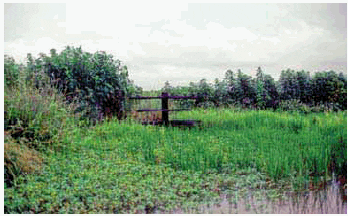
Best Management Practices
In addition to providing a highly valued and desirable seafood product, crawfish ponds serve as favorable wetland habitat to many species of waterfowl, wading birds and furbearers. Often, land that is marginal for traditional row crops is used in crawfish production. Integration of crawfish aquaculture with traditional agricultural land uses serves as a practical means of land and water conservation. Voluntary best management practices (BMPs) are an effective and practical means for conserving water and protecting the environment. Effluent or “tailwater” is discharged when rainfall exceeds pond storage capacity, when ponds are flushed to improve water quality and when drained at the end of the production season. Crawfish effluent water is usually low in nutrients and oxygen demand, but turbidity and suspended solids can be high at certain times of the year. The following set of BMPs have been identified that will minimise potential impact of crawfish pond tailwater (effluent) on the environment.
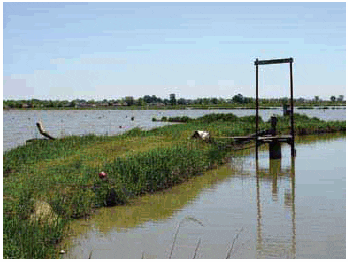
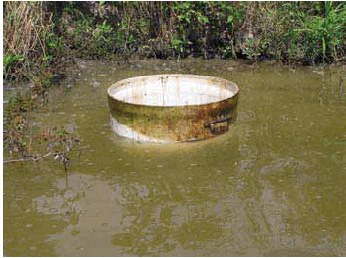
Capture and store rainfall to reduce effluent volume and pumping costs (Figure 11).
Allowing the normal pond level to fall at least 4 inches below the level of the standpipe (or more, depending on the season and pond design) from normal evaporation without re-filling will greatly reduce the volume of water leaving ponds during rainfall events by increasing the storage capacity of the pond to accumulate rainfall. Drain pipes within ponds can be painted a bright color to indicate the target water depth at which pumping is needed. An added benefit of this practice is the reduced need for pumping well water to maintain ponds at or near maximum depths.
Install drain outlets to draw overflow from the pond surface.
Water from the lower layers of a pond is generally of poorer quality than that near the surface. This difference can be especially true in terms of suspended solids, oxygen demand and nutrients. Pond drains should be constructed to allow water to leave the pond from the surface, not the bottom (Figure 12). Existing drains that draw from the pond bottom and incorporate external structures to regulate pond depth should be modified during regularly scheduled pond renovations, to draw water from near the pond surface.

Reduce pumping costs and improve flushing efficiency.
When flushing crawfish ponds in the fall to improve water quality, avoid pumping and draining at the same time. Fill the pond to one-half to two-thirds of its maximum storage capacity at initial flood-up. To flush the pond, open the drains and allow the entire pond to drop to a depth of roughly one-fourth of storage capacity, then re-fill the pond with fresh water, again to no more than one-half to two-thirds of maximum storage capacity.
This type of flushing ensures that stale water will be diluted with fresh water throughout the entire pond, preventing the establishment of “dead” areas where water will not normally flow with conventional flushing. Additionally, less water is used and released to the environment by not flooding the pond to maximum depth with the initial flood-up. The pond can be filled to maximum depth (storage capacity) in late November when temperatures have dropped sufficiently. Alternatively, baffle levees can be used to direct water flow through the pond to eliminate low oxygen areas. In areas where the quality of surface water is occasionally unacceptable or where well water must be pumped from great depths, water recirculation can be a cost-effective alternative.
Minimise sediment loading when draining.
Harvesting activity, wind and waves and crawfish foraging actions cause turbidity, or muddy water (Figure 13). Although this condition can be alleviated somewhat in crawfish-only ponds by postponing draining until most of the crawfish present have burrowed in the early summer, it poses problems in ponds where draining must be accomplished much earlier to allow for a commercial rice or other crop to be planted. In these instances, no specific recommendations have been formulated to reduce suspended sediments in ponds or tailwater, but suspending harvest activities for 1-2 weeks prior to draining may improve water clarity prior to discharge. The use of vegetated filter strips and channel vegetation (vegetated drainage ditches) also will probably be beneficial in improving water clarity because heavy sediments settle out and are trapped as water velocity is reduced as it passes through the vegetation (Figure 14). Other approaches, such as maintaining in-pond buffer zones of natural aquatic vegetation like alligatorweed, reduce the level of suspended sediments in water caused by disturbance of the pond bottom from wind and wave action and erosion of pond levees.
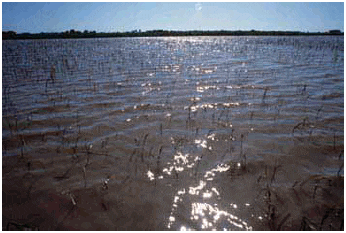
Practice water detention during summer drawdown.
A majority of suspended solids and nutrients are discharged from crawfish ponds in the remaining 10 per cent to 20 per cent of the pond water. Retaining water several days prior to complete draining or allowing the remaining water to evaporate if the production practice will allow for this can significantly reduce nutrient loads in tailwater because many nutrients are bound to particles of sediment, which can settle out of the water column prior to discharge (Figure 15).
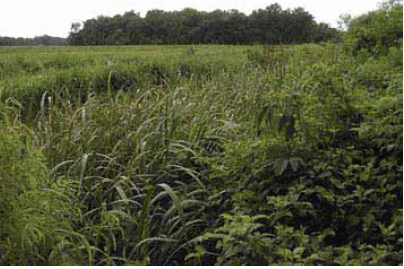
Reuse pond water.
To save on pumping costs, conserve groundwater and reduce tailwater discharge, if possible; pond water can be pumped into adjacent ponds or reservoirs and then reused. Transfer can usually be accomplished with a low-lift pump, and water can be replaced later by siphon. In some circumstances, it may be possible to drain water directly into ponds with lower elevations.
Use tailwater for irrigation.
Under some conditions, pond water discharge can be used to irrigate crops. Most crawfish aquaculture in Louisiana occurs in areas used for rice agriculture, and crawfish ponds are frequently adjacent or in close proximity to rice crops. Tailwater discharged in spring and summer into drainage ditches can be re-lifted or, in some cases, directly used to irrigate and replenish water in rice fields, which are planted in mid-March through April (Figure 16). Under some circumstances, diverting pond discharge can result in excessive erosion, so care must be taken when considering this practice.
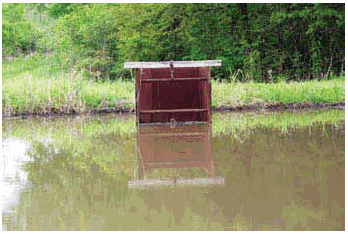
Use natural or constructed wetlands and sedimentation ditches to reduce tailwater solids and nutrients.
Natural wetlands are an effective means of treating aquaculture effluents, but care must be taken not to overload these systems. The presence of established stands of aquatic plants in spring and summer in ponds with volunteer vegetation increases nutrient uptake and reduces the level of suspended sediments in water caused by disturbance of the pond bottom from wind and wave action and erosion of pond levees.
Although dense stands of volunteer aquatic plants are usually considered problematic in commercial crawfish operations, establishing manageable stands or strips of aquatic plants, such as alligatorweed, inside ponds, even when using cultivated forages such as rice or sorghum-sudangrass, may help to improve effluent quality as well as provide cover and food when other forages have become depleted. Drainage ditches, particularly those with a slight gradient and containing emergent aquatic plants, can effectively function as settling basin for heavier solids. Sediments that accumulate in drainage ditches over time and hinder drainage can be removed in some cases and used to rebuild levees (Figure 17).
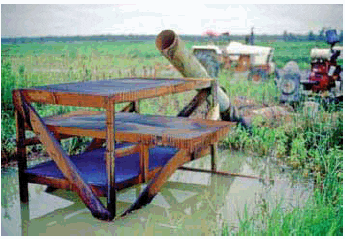
Practice erosion control in drained ponds.
When ponds are drained and idle, especially in winter in Louisiana, substantial erosion of the exposed pond bottom can occur, affecting both the serviceability of the pond and the receiving waters on the outside of the drain pipe. For this reason, drains should always be closed if possible when ponds sit empty, and ponds should be partially or completely refilled as quickly as possible.
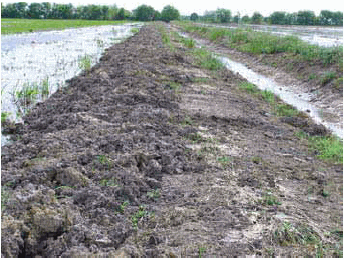
Minimise environmental impacts during pond renovation.
Use sediment from within the pond to rebuild levees and fill in low areas (Figure 18). Do not remove it from the pond unless absolutely necessary. During renovation, drains should be kept closed to minimize erosion and discharge of sediment. Levee height usually can be increased at this time to allow more management flexibility in capturing and storing rainfall or water from surrounding ponds. In this way, effluents also will be further reduced.

March 2010

